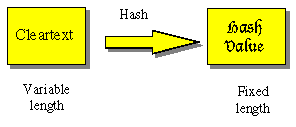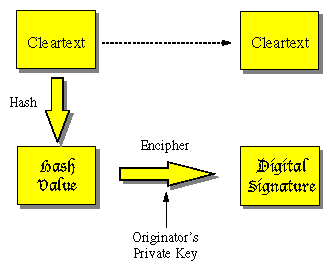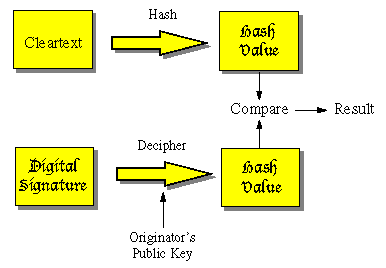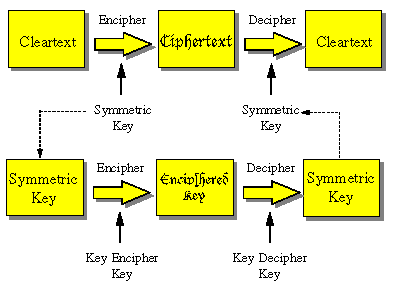
Encipher and Decipher Functions

Overview of Cryptographic Services
This is a brief introductory description of cryptographic services for those readers who are unfamiliar with the subject. For a more detailed treatise on the subject, several excellent references are available *.
Cryptographic services provide a set of functions for encoding and decoding information so that the information may be stored or exchanged securely. Cryptographic functions provide a basis for implementing the following security services:
Examples of the basic models of the application of cryptographic services are functions for the encipherment and decipherment of data, and the generation of Hash Values or Digital Signatures on sets of data. In addition functions to support key management and distribution are important.
The basic concept underlying cryptography is the enciphering of data. Encipher functions encode a set of data, termed cleartext or plaintext, into a protected format termed ciphertext using a reversible mechanism. The ciphertext may be stored or exchanged with a reduced risk of unauthorised disclosure of the data. A corresponding decipher function can be used to decode ciphertext back into its corresponding cleartext form. Thus:

Encipher and Decipher Functions
The encoding is controlled by the algorithm used and a secret value termed a key. The protection afforded to the ciphertext depends upon the strength (but not the secrecy) of the algorithm and the protection of the key used to control the algorithm. Encipherment functions preserve all the original data represented by the cleartext. This type of function is the basis of the provision of information confidentiality services.
There are two classes of encipherment algorithm:
Hash functions encode a set of data that may be of variable length using a one-way function to create a unique fixed length hash value or message digest of the set of data. The hash value is unprotected in the sense that it does not depend upon any secret value component and any individual with the same input data and same algorithm can generate the hash value.

Generate Hash value
A hash function does not preserve the original data represented by the cleartext and therefore the original cleartext cannot be recovered from a hash value. The value of these types of function are that the hash value is unique to a particular input cleartext and can therefore be used to check that the corresponding cleartext has not been modified.
A hash function is the basis of the provision of information integrity services. The hash value generated by the originator of the information is stored or exchanged with the cleartext. The recipient is able to regenerate the hash value from the received cleartext and verify that cleartext is unmodified by comparing the newly generated hash value with that received with the information.
An asymmetric encipher function and a hash function may be used in combination to provide a digital signature service. The Digital Signature is protected in the sense that its value depends upon the originatorís private key and it can therefore only be gneerated by an individual possessing that key.
First a hash value is produced by the hash function. This is then is enciphered using the asymmetric encipher function using the originatorís private key.

Generate Digital Signature
The recipient may verify the digital signature by comparing the values obtained by recomputing the hash value of the received cleartext and comparing this with the value obtained by deciphering the digital signature using the originatorís public key.

Verify Digital Signature
In order to exchange cryptographically protected information then the parties exchanging the information require to have access to the appropriate keys. This means that cryptographic keys, or information permitting their derivation, also have to be exchanged.

The strength of the protection of data using cryptographic services depends critically upon the protection of the key values used to control the algorithms. Functions to securely create and support the secure distribution of cryptographic keys are therefore an essential part of any cryptographic service. Keys may be generated or derived. A key generation function will generate a key based on random information. A key derivation function will derive a key based upon some caller defined input string, such as a pass phrase.
To distribute keys securely they are normally protected by enciphering under a Key Exchange Key, or Key Encrypting Key. Note that the individual parties exchanging keys need to have previously distributed by some other method the Key Exchange key.
The strength of the protection of data using cryptographic services depends critically upon the protection of the key values used to control the algorithms. Functions to securely create and support the secure distribution of cryptographic keys are therefore an essential part of any cryptographic service.
Keys may be generated or derived. A key generation function will generate a key based on random information. A key derivation function will derive a key based upon some caller defined input string, such as a pass phrase.
To distribute keys securely they are normally protected by enciphering under a Key Exchange Key, or Key Encrypting Key. Note that the individual parties exchanging keys need to have previously distributed by some other method the Key Exchange key.
References:
* Applied Cryptography, Bruce Schneier, John Wiley & Sons, 1996
| Home Page | Contents | FAQ | Search | Help Desk | MEMBERS ONLY | News | Events | Requirements | Technical Programme | Publications | Testing | Branding | Branded Products | Membership Information |
Wherever possible we have identified contact points for further information. If you can't find the information you need, please contact X/Open at any of of the following locations: